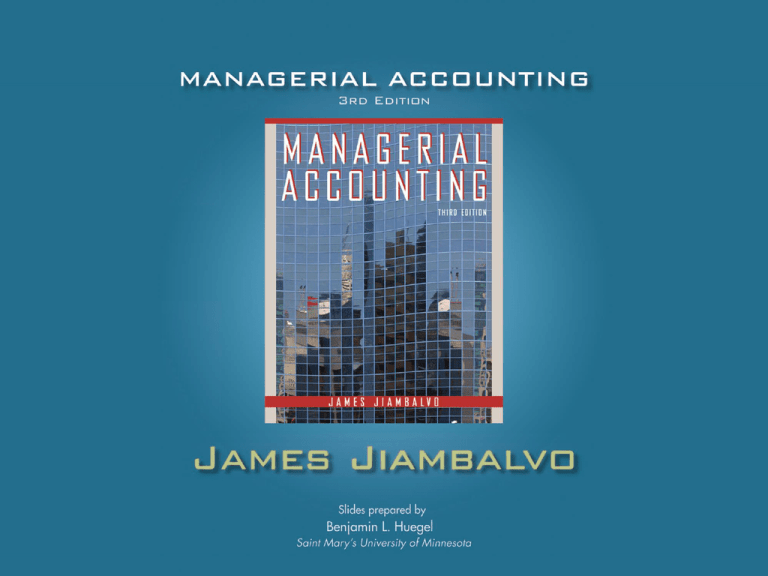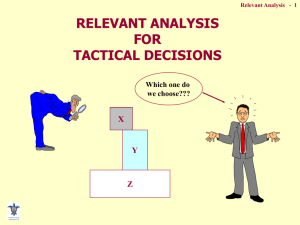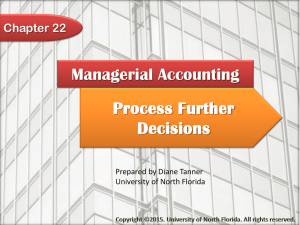
CHAPTER 7
The Use of Cost Information in
Management Decision Making
Incremental Analysis
Incremental Revenue
Additional revenue received by selecting
one alternative over another
Incremental Cost
Additional cost incurred by selecting
one alternative over another
Relevant Costs, Differential Costs
Incremental Profit
Difference between incremental revenue
and incremental cost
Incremental Analysis Example
Incremental Analysis Example
Expanded
“What does this product cost?”
Why do you want to know?
No single cost number is relevant for all
decisions
Must find incremental information that
is applicable to the decision
Analysis of Decisions Faced by
Managers
The following decisions faced by
managers require analysis of
incremental costs and/or revenues
Additional Processing of a Product
Make or Buy a Product
Drop a Product Line
Analysis of Decisions Faced by
Managers
Additional Processing of a Product
Decision to sell a product in a partially
completed stage or incur the additional
processing costs
Additional Processing Decision –
Bridge Computer Example
Summary of Cost Information
Additional Processing Decision –
Bridge Computer Example
Incremental Analysis Summary
Make or Buy Decisions
Make or Buy a Product
Decision involves no incremental revenues
Analysis concentrates solely on
incremental costs
Make-or-Buy Decisions – General
Refrigeration Example
Incremental Cost Analysis
Make-or-Buy Decisions – General
Refrigeration Example
Incremental Cost Analysis Summary
Terminology Summary
Sunk Costs
Costs that are already incurred
Are never incremental costs because they never differ
among decision alternatives
Avoidable Costs
Costs that can be avoided if a particular action is
undertaken
Opportunity Costs
Value of benefits foregone by selecting one decisions
alternative over another
Study Break #1
Which of the following is often not
a differential cost?
a.
b.
c.
d.
Material
Labor
Variable Overhead
Fixed Overhead
Study Break #1
Which of the following is often not
a differential cost?
a.
b.
c.
d.
Material
Labor
Variable Overhead
Fixed Overhead
Study Break #2
Opportunity costs are:
a.
b.
c.
d.
Never incremental costs
Always incremental costs
Sometimes sunk costs
None of the above
Study Break #2
Opportunity costs are:
a.
b.
c.
d.
Never incremental costs
Always incremental costs
Sometimes sunk costs
None of the above
Make-or-Buy Decisions – General
Refrigeration Example
Incremental Cost Analysis with Opportunity Costs
Example Exercise #1
Finn’s Seafood Restaurant has been
approached by New England Investments,
which wants to hold an employee
recognition dinner next month. Lillian
summer, a manager of the restaurant,
agreed to a charge of $65 per person for
food, wine, and dessert, for 150 people.
She estimates that the cost of unprepared
food will be $30 per person and beverages
will be $12 per person.
Example Exercise #1
Continued
In order to accommodate the group, Lillian will
have to close the restaurant for dinner that
night. Typically, she would have served 160
people with an average bill of $50 per person.
On a typical night, the cost of unprepared food is
$18 per person and beverages are $13 per
person.
No additional staff will need to be hired to
accommodate the group from New England
Investments.
Calculate the incremental profit or loss
associated with accepting the New England
Investments group.
Example Exercise #1 Solution
Calculate the incremental profit/loss
New England Investments group
Revenue ($65 x 150)
Costs Incurred ($42 x 150)
$9,750
$6,300
$3,450
Typical Evening
Revenue ($50 x 160)
Costs Incurred ($31 x 160)
$8,000
$4,960
$3,040
Incremental Profit
New England Investments Group
Typical Evening
$3,450
$3,040
$ 410
Drop a Product Line
A very significant decision
Analysis involves calculating the change in
income that will result from dropping the
product line.
If income will increase, the product line
should be dropped
If income will decrease, the product line
should be kept
Dropping a Product Line –
Mercer Hardware Example
Dropping a Product Line –
Mercer Hardware Example
Beware of the Cost Allocation
Death Spiral
When dropping a product line
Common fixed costs are not incremental
Common fixed cost allocation is spread
among remaining product lines
Management must understand and
remember this impact when making
decisions
Decisions Involving Joint Costs
Joint Products
When two or more products always result
from common inputs
Joint Costs
Costs of the common inputs
Split-Off Point
Stage of production in which individual
products are identified
Joint Products Example
Allocation of Joint Costs
Cost of the common inputs
Allocated to the joint products for financial reporting
purposes
Joint cost information is
Irrelevant to individual joint product decisions
It is not an incremental cost
Joint cost information is relevant to decisions
regarding joint products as a group
Example Exercise #2
The American Produce Company purchased a truckload of
cantaloupe (weighing 5,000 pounds) for $1,000
American Produce separated the cantaloupe into two
grades: superior and economy.
The superior grade cantaloupe had a total weight of 4,000
pounds which sells for $0.30 per pound
The economy grade cantaloupe totaled 1,000 pounds which
sells for $0.10 per pound
Allocate the $1,000 cost of the truckload to the superior
grade and economy grade cantaloupe using the physical
quantity method and relative sales value method.
Example Exercise #2 Solution
Physical Quantity Method
Superior Grade
= (4,000/5,000) x $1,000
= $800
Economy Grade
= (1,000/5,000) x $1,000
= $200
Example Exercise #2 Solution
Relative Sales Value Method
Total Sales
Superior Grade
Economy Grade
Total Sales
4,000 x $0.30 = $1,200
1,000 x $0.10 = $100
$1,300
Cost Allocation
Superior Grade (1,200/1,300) x $1,000 = $923
Economy Grade (100/1,300) x $1,000 = $ 77
Additional Processing Decisions
and Joint Costs
Joint costs
Not relevant to decisions made after the
split-off point
Joint costs incurred prior to the
split-off point are sunk costs
Decisions based on incremental
analysis
Study Break #3
Which of the following costs should
not be taken into consideration
when making a decision?
a.
b.
c.
d.
Opportunity costs
Sunk costs
Relevant costs
Differential costs
Study Break #3
Which of the following costs should
not be taken into consideration
when making a decision?
a.
b.
c.
d.
Opportunity costs
Sunk costs
Relevant costs
Differential costs
Study Break #4
The joint costs incurred in a joint
product situation:
a. Are incurred before the split-off point
b. Are incurred after the split-off point
c. Should only be allocated based on physical
attributes
d. None of the above
Study Break #4
The joint costs incurred in a joint
product situation:
a. Are incurred before the split-off point
b. Are incurred after the split-off point
c. Should only be allocated based on physical
attributes
d. None of the above
Qualitative Considerations in
Decision Analysis
Most make-or-buy
decisions have one
or more features
that are difficult to
quantify but
should be
considered
Swings in Economy
Loss of Control
Quality of Product
Quality of Service
Company Morale
Qualitative Factors
The Five-Step Process of the
Theory of Constraints
1. Identify the Binding Constraint
2. Optimize Use of the Constraint
3. Subordinate Everything Else to the
Constraint
4. Break the Constraint
5. Identify a New Binding Constraint
Production Flow
Overproduction in Nonbottleneck Departments
Copyright
© 2007 John Wiley & Sons, Inc. All rights
reserved. Reproduction or translation of this
work beyond that permitted in Section 117 of the
1976 United States Copyright Act without the
express written permission of the copyright
owner is unlawful. Request for further
information should be addressed to the
Permissions Department, John Wiley & Sons,
Inc. The purchaser may make back-up copies for
his/her own use only and not for distribution or
resale. The Publisher assumes no responsibility
for errors, omissions, or damages, caused by the
use of these programs or from the use of the
information contained herein.





